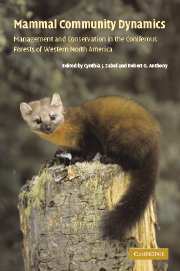 Mammal Community Dynamics
Mammal Community Dynamics Book contents
- Frontmatter
- Contents
- List of contributors
- Foreword
- Acknowledgments
- Part I Management and conservation issues for various taxa
- 1 Introduction and historical perspective
- 2 Forests and woodlands of western North America
- 3 Faunal composition and distribution of mammals in western coniferous forests
- 4 Habitat ecology and conservation of bats in western coniferous forests
- 5 Ecological relationships of terrestrial small mammals in western coniferous forests
- 6 Ecology and conservation of arboreal rodents of western coniferous forests
- 7 Small and mid-sized carnivores
- 8 Ecology, conservation, and restoration of large carnivores in western North America
- 9 Ungulates in western coniferous forests: habitat relationships, population dynamics, and ecosystem processes
- Part II Community and ecosystem relations
- Part III Conservation issues and strategies
- Index
- References
9 - Ungulates in western coniferous forests: habitat relationships, population dynamics, and ecosystem processes
Published online by Cambridge University Press: 15 December 2009
- Frontmatter
- Contents
- List of contributors
- Foreword
- Acknowledgments
- Part I Management and conservation issues for various taxa
- 1 Introduction and historical perspective
- 2 Forests and woodlands of western North America
- 3 Faunal composition and distribution of mammals in western coniferous forests
- 4 Habitat ecology and conservation of bats in western coniferous forests
- 5 Ecological relationships of terrestrial small mammals in western coniferous forests
- 6 Ecology and conservation of arboreal rodents of western coniferous forests
- 7 Small and mid-sized carnivores
- 8 Ecology, conservation, and restoration of large carnivores in western North America
- 9 Ungulates in western coniferous forests: habitat relationships, population dynamics, and ecosystem processes
- Part II Community and ecosystem relations
- Part III Conservation issues and strategies
- Index
- References
Summary
Introduction
Wild ungulates play important roles in coniferous forest throughout western North America. Their biology is well known compared with that of other species of wildlife. They have sufficiently large home ranges to integrate spatial patterns across landscapes. Finally, they are often migratory (Wallmo 1981, Nicholson et al. 1997). Their life-history characteristics require consideration of entire landscapes rather than isolated patches of habitat for purposes of conservation and management (Hanley 1996, Kie et al. 2002). Ungulates require temporally and spatially diverse habitat components such as food and cover. These mammals can have significant effects on vegetation composition and basic ecosystem processes such as nutrient cycling, thereby acting as keystone species (Molvar et al. 1993, Wallis de Vries 1995, Hanley 1996, Hobbs 1996, Nicholson et al. 1997, Simberloff 1998, Kie et al. 2002).
Ungulates have economic value to society as well. Most species provide recreational hunting opportunities and also can have non-consumptive, aesthetic values (Loomis et al. 1989). Conversely, ungulates can cause damage to gardens and other landscaping (Conover 1997), to agricultural crops, (Austin and Urness 1993), and to new tree seedlings (Bandy and Taber 1974). Damage from deer–vehicle collisions also can be substantial (Romin and Bissonette 1996).
Four species of ungulates, all members of the family Cervidae, commonly occur in coniferous forests in western North America: elk (Cervus elaphus), moose (Alces alces), mule and black-tailed deer (Odocoileus hemionus), and white-tailed deer (Odocoileus virginianus).
- Type
- Chapter
- Information
- Mammal Community DynamicsManagement and Conservation in the Coniferous Forests of Western North America, pp. 296 - 340Publisher: Cambridge University PressPrint publication year: 2003
References
- 37
- Cited by


